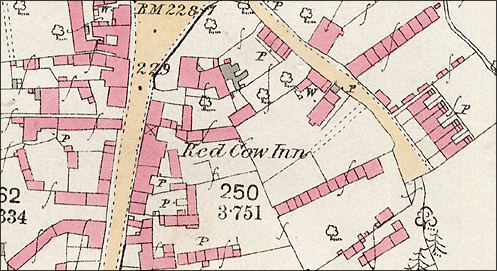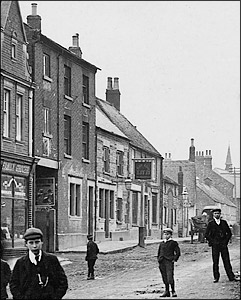One of the earliest references we have to The Red Cow is when mention was made of it in a criminal case dated 1836. Its landlord, Thomas Collins, gave evidence that three men, later found asleep in a haystack between Burton Latimer and Pytchley, had visited his pub after robbing the Honourable and Reverend James Douglas of Broughton Rectory of all his silverware and £40 in cash. The silverware was found buried close to where they were sleeping. The three men, John Anstice, William Jones and Benjamin Gore, were sentenced to death but this was afterwards commuted to life imprisonment.
In 1856, the then landlord, Edward Quincey, felt obliged to write to the editor of the Northampton Mercury thus:
To the Editor of the Northampton Mercury - Burton Lattimer, Sept. 6th 1856. Sir, - In your newspaper of the 6th inst., you will find the following. – “William Keep inspector of police at Kettering, charged John Croxen, landlord of the Red Cow, Burton Lattimer,” &c. This is incorrect; John Croxen is landlord of the Duke’s Arms, not the Red Cow. Will you be good enough to correct this in your next impression. I am, Sir, your respectfully, EDWARD QUINCEY, Landlord of the Red Cow, Burton Lattimer
|
The following articles relate to (John) Thomas Whitney, who was the licensee at the time of the reported offences in 1891 and 1892. His main occupation was as a builder. His wife, Harriet Ann looked after the pub during the day. A daughter (Emma) mentioned in the extracts would have been 14 years of age.
Extract from The Northampton Mercury 30 January 1891
BRANDY TROUBLE
Thomas Whitney, innkeeper, Burton Latimer, was summoned for a breach of the Food and Drugs Act, and also for a breach of the Weights and Measures Act.
Mr P L Rawlins defended.
Samuel Clowes, Inspector under the Act for the Northern Division of the County, said his assistant purchased a pint of brandy from defendant's house. Witness paid for the liquor, which was drawn in a mug that was not stamped, and he told Mrs Whitney that it was purchased for the purpose of analysis. After the purchase was completed Mrs Whitney said it was not the best brandy, and pointed to a notice that was hidden behind some measures on the shelf, and which stated that no alcoholic strength was guaranteed. The notice coould not be seen till the measures were moved. The analysis of Dr Emmerson, to whom the brandy was delivered, showed that it wqas 33.2 below proof, or 8.2 below the standard allowed by the Act. The mug in which the brandy was served was a quarter of a gill short.
The defence was that the notice stating that the liquers were sold as diluted was placed in such a position that persons purchasing could see it, and that also the Inspector had verbal notice of the dilution.
Several witnesses were called to speak to this. One of the witnesses called was the village constable.
After a long hearing, the Bench dismissed the first charge, and on the second fined defendant 5s. and costs.
-----------------------------------------------------------------------------------------
Extract from The Northampton Mercury 22 July 1892
MORE TROUBLE - DRUNKENNESS
Thos. Whitney, Burton Latimer, was summoned for being drunk on his own licensed premises on June 30th.
Mr W J Henry appeared for defendant.
PC Currin stated that on the evening of the day named he heard screams proceeding from the Red Cow Inn, and as he was sent for by the defendant's wife he went there, and Mrs Whitney asked him to protect her daughter from defendant. Witness went upstairs and there found defendant, who was mad druni, threatening his daugther, who was locked up in one of the rooms. He said he would kill her, and when witness advised him to be quiet, he threatened to throw him downstairs. The defendant was quite drunk and was most violent. Witness had had repeatedly to caution defendant and to remain in the house in consequence of his violence. The disturbance lasted about half an hour, and caused quite a commotion both inside the house and outside.
John Parker, shoe manufacturer, Finedon, stated that he saw defendant would not have done what he did unless he had been drunki.
Mr Henry, in defence, said defendant was only labouring under excitement, owing to his daughter's disobedience.
Defendant, on being sworn, said he had been at work at Irthlingborough all day on the 30th June, and only had two glasses of beer during the whole time.
John Burton (a lodger), William Draft (an employee), Frank Rains (a customer), and Mrs Whitney, all gave evidence that defendant was not drunk, and the Bench dismissed the case.
|
|
|
|
The Red Cow Inn in about 1900
Close inspection of the frontage of the building will show that
the later painting of the face of the inn (see below) obscured
the fact that it was actually two separate original buildings.
The three storey section is built of brick in the style of a Georgian
townhouse. The two-storey section is a (presumably earlier)
stone building.
Note that the inn signpost was set into the edge of the road, and
that beside the right-hand corner of the topmost window cills on
the brick building there are projecting metal flag-holders. Such
holders were common on buildings in town at the time.
The large horse and vehicle entrance gave access to stabling
facilities alongside the rear yard (see the "Good Stabling" claim
on the left-hand billboard of the 1912 photo, below).
|
|
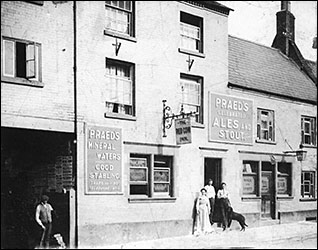 |
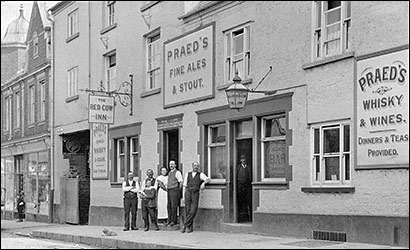 |
Above left: The Red Cow in 1912. Frederick William Dicks, the licensee, with his wife Edith and eldest son Edward John (Ted). In commercial directories for 1906, 1910 & 1914 Frederick was also described as town crier. Ted Dicks was a window cleaner in later life. Just before this photograph was taken the sign had been removed from a post in the street and hung on the wall.
Above right: The Red Cow in 1929. Frank Clarke (second from right) was licensee. By this time it had been repainted, the dark shade being a crimson colour. |
|
|
The table below shows the earliest and/or latest dates we have for each of the landlords occupying the premises.
| Joseph Allen |
1820-1822 |
|
William Norton |
1897-1911 |
| John Croxen |
1827 |
|
Frederick WIlliam Dicks |
1911-1915 |
| Thomas Collins |
1836-1850 |
|
Frank Clarke |
1920 |
| Edward Quincey |
1851 |
|
Joseph E Goodman |
1931 |
| Thomas Whitney |
1885-Jan.1893 |
|
Lewis Owen |
1945 |
| Ernest J Headland |
1957 (poss. just occupant) |
|
|
|
|
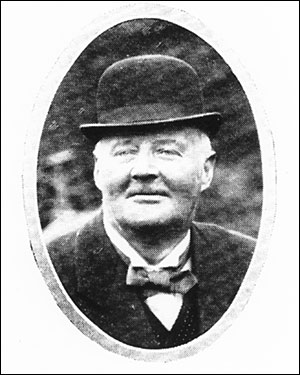 |
|
William Norton,
a native of Cranford St John,
landlord at The Red Cow 1897-1911
|
|
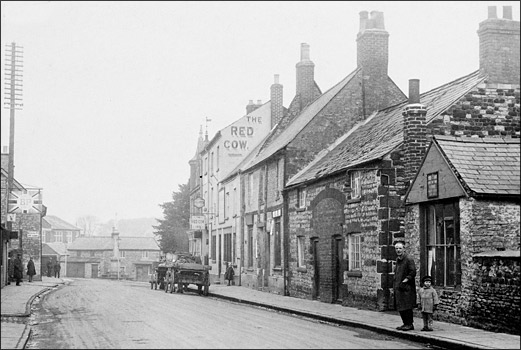 |
|
On a hazy day in about 1925, two horse-drawn heavy float carts line up
outside the Red Cow. The empty sacks on the nearest one suggest that
it may be a coalman's delivery cart.
Note the painted inn name on the south face of larger three-storey building.
|
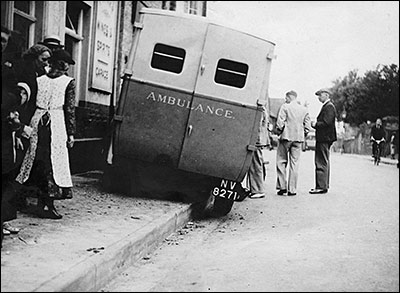 |
| This famous picture, taken in 1938, shows the Burton Latimer St John Ambulance Brigade's ambulance on the pavement directly outside The Red Cow.
The vehicle was being driven by Herbert Long along the High Street when it suffered brake failure causing it to mount the curb and make an unexpected call at the Inn.
|
|
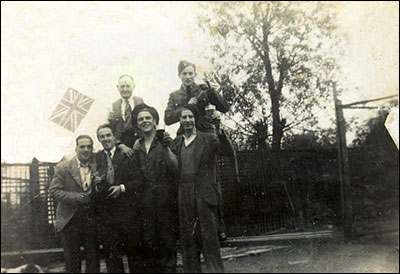 |
This photograph, thought to be taken in the back
garden of The Red Cow, seems to be celebrating
something to do with World War II.
Back Row - Lew Owen (landlord), Charlie Catling.
Front row - Addie Cheaney, Roger Saddington,
Ron (Dot) Johnson, Eddie Baxter. |
|
Like most pubs, The Red Cow sported teams in various leagues; three of them are pictured here.
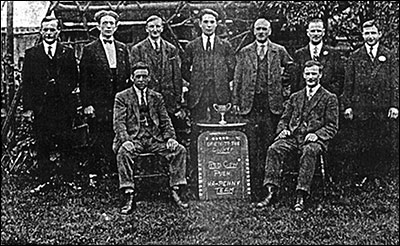 |
|
This poor quality reproduction is of The Red Cow Push Ha'penny Team in the late 1920s. The landlord was Frank Clarke who is thought to be last but one on the back row.
|
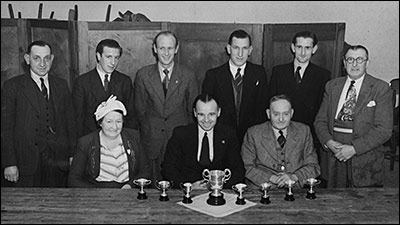 |
|
Red Cow Darts Team - 1950s (?)
Standing: Bob Coles, Fred Craddock, Eddie Murgatroyd,
George Craddock, Derick Cole, (?) Seated: Beatrice Owen,
Arthur Clements, Lew Owen (Landlord).
|
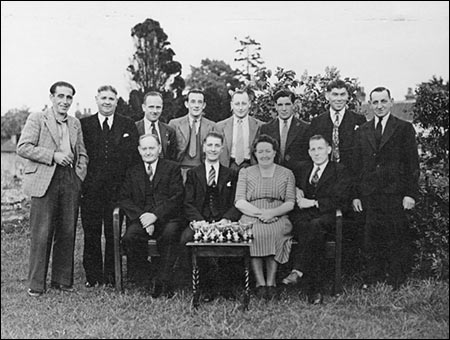 |
|
Red Cow Darts Team - 1950s
Standing: Bernie Evans, Percy Toseland, Owen Thomas, Harry Holland, ... Pinnock, Jack Craddock, Bert Hobbs, Bob Coles.
Seated: Lew Owen (Landlord), Eddie Baxter, Mrs Owen, Charlie Johnson.
|
|
The Red Cow, formerly a High Street coaching Inn, finally closed as a pub in 1956. It was converted into two commercial premises. To read about its history from this point, please click here.
By 2008 all commercial activity had ceased and the property was sold for revelopment. It stood empty for a number of months before scaffolding went up in autumn 2008. Demolition began in January 2009.
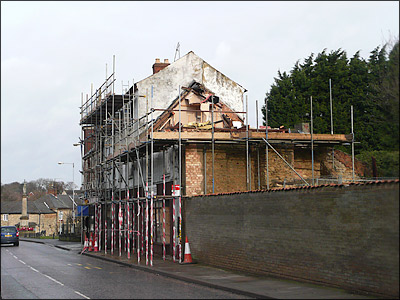 |
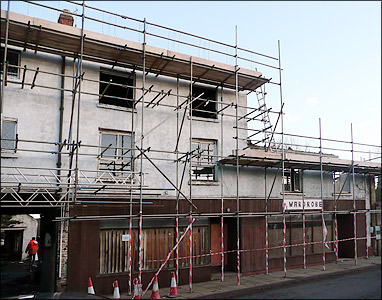 |
|
January 2009 - the former Red Cow Inn reaches the "twilight's last gleaming" moment as demolition starts
|
|
